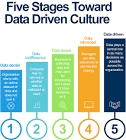In today’s fast-paced and competitive world, businesses are constantly looking for ways to stay ahead of the game. One of the most effective ways to do this is by making data-driven decisions. Data-driven decision making involves using data to inform and guide business decisions, rather than relying solely on intuition or past experiences.
Data-driven decision making has become increasingly popular in recent years due to the availability of large amounts of data and advancements in technology that allow for easier analysis. By using data analytics tools, businesses can analyze vast amounts of data quickly and efficiently, allowing them to make informed decisions based on real-time insights.
One of the key benefits of data-driven decision making is that it reduces the risk of making poor decisions based on incomplete or inaccurate information. By using data to inform decisions, businesses can ensure that they are basing their choices on reliable and accurate information.
Another benefit of data-driven decision making is that it allows for more targeted and personalized marketing strategies. By analyzing customer data, businesses can identify patterns and trends that can be used to create more effective marketing campaigns. For example, a business may use customer purchase history to create targeted promotions or offers that are more likely to resonate with individual customers.
Data-driven decision making also helps businesses identify areas where they can improve efficiency and reduce costs. By analyzing operational data, businesses can identify bottlenecks or inefficiencies in their processes and make changes to improve productivity.
However, it is important to note that data-driven decision making should not be used as a replacement for human judgement. While data provides valuable insights, it cannot replace human intuition or experience. Instead, businesses should use a combination of both data analysis and human judgement when making important decisions.
In conclusion, data-driven decision making has become an essential tool for businesses looking to stay competitive in today’s fast-paced environment. By using real-time insights from data analysis tools, businesses can make informed decisions that reduce risk, improve efficiency, and increase profitability.
Answers to Frequently Asked Questions About Data-Driven Decision Making
- What does it mean to be data driven?
- What are the 4 steps of data driven decision making?
- What is an example of a data driven decision?
- Why is data driven decision making important?
What does it mean to be data driven?
Being data-driven means making decisions based on data and insights rather than relying solely on intuition or past experiences. It involves using data to inform and guide decision-making processes across various aspects of a business, including marketing, operations, finance, and strategy.
To be data-driven, businesses must have access to reliable and accurate data, which can be analyzed using various tools and techniques to gain insights. Once these insights are obtained, they can be used to make informed decisions that are more likely to lead to positive outcomes.
Being data-driven also involves a culture of continuous improvement. Businesses must regularly collect and analyze data to identify areas for improvement and make changes accordingly. This requires a commitment to ongoing learning and development, as well as a willingness to adapt and change course based on new information.
In summary, being data-driven means using data as the foundation for decision-making processes. By doing so, businesses can gain valuable insights into customer behavior, operational efficiency, financial performance, and other key areas of their operations that can help them stay competitive in today’s fast-paced business environment.
What are the 4 steps of data driven decision making?
The four steps of data-driven decision making are as follows:
- Define the problem: The first step in data-driven decision making is to define the problem or question that needs to be addressed. This involves identifying the key areas of concern and determining what data is needed to address those concerns.
- Collect and analyze data: Once the problem has been defined, the next step is to collect and analyze relevant data. This may involve gathering data from various sources, such as internal databases, surveys, or external sources. The data is then analyzed using statistical methods or other tools to identify patterns and trends.
- Develop insights: After analyzing the data, the next step is to develop insights based on the findings. This involves interpreting the results of the analysis and drawing conclusions about what they mean for the business. These insights should be actionable and relevant to the problem that was initially defined.
- Make decisions: The final step in data-driven decision making is to use the insights developed in step three to make informed decisions. This may involve implementing changes based on the findings or deciding on a course of action based on the insights gained from analyzing the data.
By following these four steps, businesses can make informed decisions that are based on real-time insights rather than intuition or past experiences alone. This can lead to improved efficiency, reduced costs, and increased profitability over time.
What is an example of a data driven decision?
An example of a data-driven decision could be a retail company using customer purchase data to inform their inventory management strategy. By analyzing which products are selling the most and at what times of the year, the company can make informed decisions about which products to stock and in what quantities. This can help reduce the risk of overstocking on products that are not selling well, while ensuring that popular items are always in stock. Additionally, by analyzing customer purchase patterns, the company may identify opportunities to cross-sell or upsell related products, which can increase revenue and improve customer satisfaction. Overall, this data-driven approach to inventory management can help the company optimize their operations and improve profitability.
Why is data driven decision making important?
Data-driven decision making is important because it helps businesses make informed decisions based on real-time insights and reliable information, rather than relying solely on intuition or past experiences. There are several reasons why data-driven decision making has become increasingly popular and essential for businesses:
- Reduces the risk of making poor decisions: By using data to inform decisions, businesses can ensure that they are basing their choices on accurate and reliable information, reducing the risk of making poor decisions based on incomplete or inaccurate information.
- Improves efficiency: Data-driven decision making allows businesses to identify bottlenecks or inefficiencies in their processes and make changes to improve productivity, leading to increased efficiency and reduced costs.
- Increases profitability: By analyzing customer data, businesses can identify patterns and trends that can be used to create more effective marketing campaigns, leading to increased sales and profitability.
- Provides a competitive edge: Businesses that use data-driven decision making have a competitive advantage over those that rely solely on intuition or past experiences.
- Helps identify new opportunities: By analyzing market trends and customer behavior, businesses can identify new opportunities for growth and expansion.
In summary, data-driven decision making is important because it helps businesses make informed decisions based on reliable information, reduces the risk of poor decision-making, improves efficiency, increases profitability, provides a competitive edge, and helps identify new opportunities for growth.




